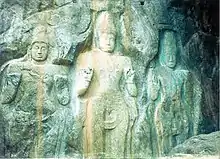
Buduruwagala is an ancient Buddhist temple in Sri Lanka. The complex consists of seven statues and belongs to the Mahayana school of thought. The statues date back to the 10th century. The gigantic Buddha statue still bears traces of its original stuccoed robe and a long streak of orange suggests it was once brightly painted. The central of the three figures to the Buddha's right is thought to be the Buddhist mythological figure-the Bodhisattva Avalokitesvara. To the left of this white painted figure is a female figure in the thrice-bent posture, which is thought to be his consort-Tara.
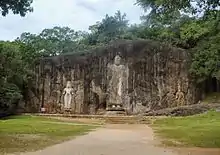
Name
Buduruvagala means "the rock of Buddhist Sculptures". The name Buduruwagala is derived from the words for Buddha (Budu), images (ruva) and stone (gala). Most visitors, especially Buddhists, who attend the temple will make sure to visit Buduruvagala.
Location
Buduruvagala is located about 4 miles (6.4 km) southeast of Wellawaya in Monaragala district, Sri Lanka.[1]
Size of the statues
The largest of the standing Buddha statues is 51 feet (16 m) from head to toe; is the largest standing Buddha statue of the island.[2]
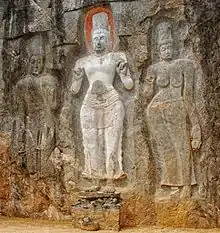
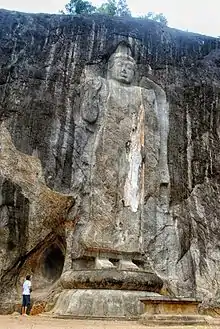
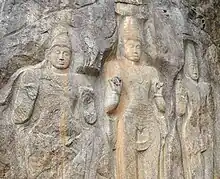
History
Authorities generally date them to the 9th or 10th century.[2] Buduruvagala does not have much historical records. Even its original name is unknown. It is thought to be a hermitage for monks. The sculptures of Buduruvagala also include many sculptures of Bodhisattva images including Mahayana tradition.[3]
The mustard oil lamp
On the same rock where the sculptures are carved, there is a carved shape of about 3 feet (0.91 m) wide and 4 feet (1.2 m) height. It is of the shape of a flame. The inside wall of this carved shape is always wet of an oil that smells very much like Mustard oil. This oil comes to the carved shape with no explainable source or reason.
See also
References
- ↑ Sacred Island - A Buddhist Pilgrim's Guide to Sri Lanka Buduruvagala
- 1 2 Buduruvagala, "Buduruvagala". Archived from the original on 2008-07-08. Retrieved 2007-09-08.
- ↑ Buddha's Rock Mahayana Legacy at Buduruvagala